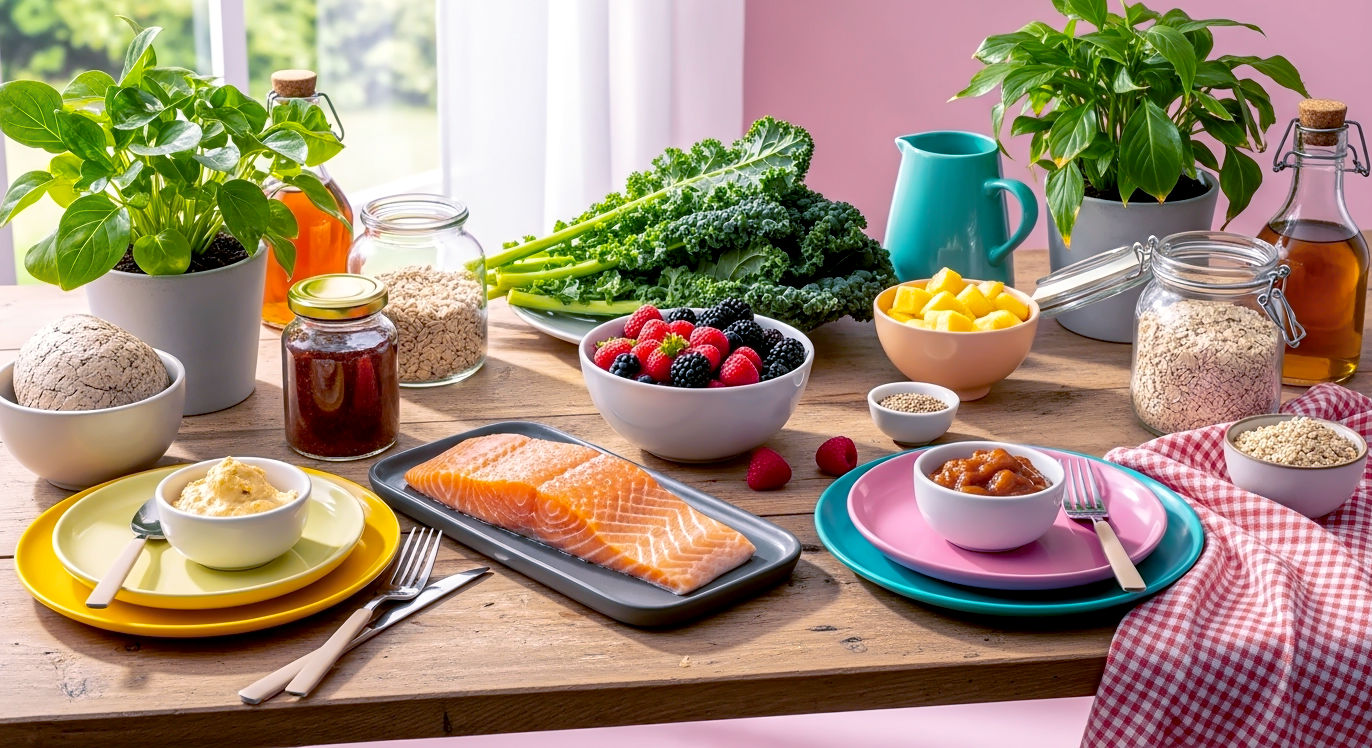The Ultimate Guide to Wholesome Eating: 10 Foods to Power Your Week
Your definitive guide to the 10 most wholesome foods to eat every week. From Scottish salmon to British oats, learn why they’re brilliant for you and how to enjoy them.

This post may contain affiliate links. If you make a purchase through these links, we may earn a commission at no additional cost to you.
Let’s be honest, trying to eat healthily can feel like a full-time job. One minute, we’re told to avoid carbs like the plague; the next, a new diet says we should only eat things a caveman would have recognised. It’s confusing, it’s often expensive, and frankly, it can take all the joy out of our food.
But what if we stripped it all back? What if, instead of focusing on what to cut out, we focused on what to add in?
Welcome to your no-nonsense guide to eating well. This isn’t a diet. There are no strict rules or forbidden foods here. Instead, this is a celebration of ten wonderfully wholesome foods that are easy to find in any British supermarket, won’t break the bank, and can make a huge difference to how you feel, day in and day out. We’re talking about simple, powerful ingredients that can boost your energy, sharpen your mind, and keep your body running smoothly.
Think of this as your toolkit for building a healthier, happier relationship with food. We’ll explore why these ten foods are so brilliant for you, how to easily fit them into your weekly shop, and share some dead simple ways to cook them. Let’s get started.
What Does ‘Wholesome’ Actually Mean? (Hint: It’s Simpler Than You Think)
You hear the word ‘wholesome’ thrown around a lot, but it’s often just marketing fluff. For our purposes, it means something very simple: food that’s as close to its natural state as possible. Think an apple, not apple-flavoured sweets. A fillet of salmon, not a breaded fish finger. Brown rice, not a sugary rice pudding.
These foods are packed with the good stuff our bodies need to thrive. You can think of them as your body’s building blocks and fuel.
- The Big Three (Macronutrients): These are the main sources of energy.
- Proteins: Essential for building and repairing everything from muscles to skin. Found in things like fish, eggs, and lentils.
- Carbohydrates: Your body’s main fuel source, especially for your brain. The best ones are ‘complex’ carbs like oats and root veg, which release energy slowly.
- Fats: Yep, you need fats! Healthy fats are vital for brain health and absorbing certain vitamins. You’ll find them in oily fish, nuts, and seeds.
- The Support Crew (Micronutrients): These are the vitamins and minerals that do thousands of important jobs, from helping you fight off colds to keeping your bones strong. Wholesome foods are absolutely brimming with them.
The goal here isn’t to become a nutritionist overnight. It’s simply to understand that choosing whole, unprocessed foods gives your body the best possible toolkit to work with. Now, let’s look at the ten all-stars you should be adding to your trolley every week.
1. Oats: The Humble Breakfast Champion
If there’s one food that deserves a cape, it’s the humble oat. For centuries, we Brits have started our days with a warm bowl of porridge, and for good reason. Oats are cheap, filling, and incredibly good for you.
Why They’re a Must-Eat
Oats are famous for a type of soluble fibre called beta-glucan. It sounds scientific, but its job is simple: it acts like a sponge in your gut, helping to lower cholesterol and keep your blood sugar levels stable. This means you feel fuller for longer and avoid that mid-morning slump where you’re reaching for the biscuit tin. They provide a slow, steady release of energy, which is perfect for fuelling a busy morning.
The British Love Affair with Porridge
From the Scottish Highlands, where “stirring the spurtle” is an art form, to a quick microwave bowl before the school run, porridge is a national institution. But oats are more versatile than you might think. You can use them in crumble toppings, blend them into smoothies for extra thickness, or make your own granola. Scottish oatcakes are also a fantastic, savoury alternative to crackers.
How to Buy and Use Oats Like a Pro
- Choose the right kind: Look for rolled oats or jumbo oats. They have a better texture and are less processed than the ‘instant’ or ‘easy cook’ sachets, which are often loaded with sugar. A big bag of simple rolled oats is one of the best-value items in the supermarket.
- Perfect your porridge: The classic way is to cook them with milk or water on the hob, stirring until creamy. But if you’re short on time, making ‘overnight oats’ is a game-changer. Just mix oats with milk or yoghurt in a jar, add some fruit, and leave it in the fridge overnight. Breakfast is ready when you wake up!
- Get creative with toppings: A swirl of honey, a sprinkle of cinnamon, a handful of berries, or a spoonful of nut butter can turn a simple bowl of porridge into something special.
2. Oily Fish: Brain Food from British Waters
We’re lucky in the UK to have access to fantastic oily fish from the cold waters around us. Think salmon, mackerel, sardines, and trout. Eating a portion or two a week is one of the best things you can do for your brain and heart.
The Magic of Omega-3s
Oily fish are packed with a type of healthy fat called omega-3. Our bodies can’t make it from scratch, so we have to get it from our food. Omega-3s are superstars for our health. They help reduce inflammation, keep your heart beating regularly, and are absolutely essential for brain function. In fact, our brains are made up of about 60% fat, so omega-3s are literally the building blocks for a sharp mind.
Choosing Your Fish: Salmon, Mackerel, and More
- Scottish Salmon: Renowned worldwide, it’s a fantastic choice. Look for responsibly farmed or wild salmon.
- Mackerel: A brilliant, budget-friendly option. It’s strong in flavour and delicious when grilled or smoked. A smoked mackerel pâté is a classic British starter.
- Sardines and Pilchards: Don’t overlook the tinned aisle! Tinned sardines are cheap, convenient, and a nutritional powerhouse. They’re also great because you eat the tiny, soft bones, which gives you a big calcium boost.
Simple Ways to Get More Oily Fish in Your Diet
You don’t need to be a fancy chef to cook fish.
- Bake it: A salmon fillet baked in foil with a slice of lemon and some herbs takes about 15-20 minutes and is virtually foolproof.
- Grill it: Mackerel fillets take just a few minutes under the grill. Serve with a squeeze of lemon and some salad.
- Flake it: Flake smoked mackerel or leftover cooked salmon into salads, pasta, or mix with cream cheese and horseradish for a quick pâté to spread on oatcakes.
3. Leafy Greens: Your Green Powerhouse
Your mum was right: you need to eat your greens. Dark leafy greens like kale, spinach, rocket, and watercress are some of the most nutrient-dense foods on the planet.
More Than Just a Bit on the Side
These greens are bursting with vitamins and minerals. They’re an excellent source of Vitamin K (for healthy bones and blood), Vitamin A (for vision and your immune system), and folate (crucial for cell growth). Spinach is also famous for its iron content, which helps carry oxygen around your body and fights tiredness. While the iron in spinach is a bit harder for our bodies to absorb than the iron in meat, pairing it with a food high in Vitamin C (like a squeeze of lemon juice) can give it a helping hand.
From Kale Crisps to Super Smoothies
- Don’t boil them to death! The biggest crime against greens is overcooking them until they’re a sad, soggy mess. Instead, try steaming or lightly wilting them.
- Spinach: A big bag looks like a lot, but it wilts down to almost nothing. Throw a huge handful into curries, stews, or pasta sauces right at the end of cooking. It will wilt in a minute or two.
- Kale: This can be a bit tough. The trick is to remove the woody stems and massage the leaves with a little olive oil and salt before using them in a salad. This softens them up beautifully. Or, toss the leaves in a little oil and bake them in the oven until crispy to make amazing ‘kale crisps’.
- Smoothies: A handful of spinach in a fruit smoothie is a brilliant way to get a dose of greens without even tasting them.
A Guide to Buying and Storing Greens
Buy them fresh and use them within a few days. To keep them from going slimy, store them in the salad drawer of your fridge with a piece of kitchen roll in the bag to absorb any excess moisture.
4. Berries: Nature’s Sweetest Health Boost
When the sun is shining, there’s nothing better than a punnet of fresh British strawberries, raspberries, or blueberries. These little jewels aren’t just delicious; they’re a proper health boost.
A Burst of Antioxidant Power
Berries are famous for being loaded with antioxidants. Think of antioxidants as your body’s personal bodyguards. They help protect your cells from damage caused by everyday life, a bit like how rust-proofing protects a car. This cellular protection is thought to help reduce the risk of many long-term health problems. The deep red, blue, and purple colours of berries come from these powerful plant compounds.
Making the Most of British Berry Season
The British berry season, which typically runs from May to September, is a real treat. They taste so much better when they haven’t been flown halfway across the world. Visiting a local ‘pick your own’ farm is a fantastic family day out and a great way to get the freshest berries possible.
Fresh vs. Frozen: What’s Best?
While fresh British berries are unbeatable in summer, don’t shy away from the freezer aisle during the rest of the year. Frozen berries are picked and frozen at their peak, so they often lock in more nutrients than fresh ones that have been sitting on a lorry for days. They are also much cheaper. Frozen berries are perfect for smoothies, stirring into porridge, or making a quick fruit compote to serve with yoghurt.
5. Lentils and Pulses: The Unsung Heroes of the Pantry
For generations, lentils, beans, and chickpeas have been the backbone of hearty, budget-friendly meals. They are the quiet achievers of the food world—cheap, versatile, and incredibly good for you.
Why Your Gran Was Right About Lentil Soup
Lentils and other pulses are a fantastic source of plant-based protein and fibre. The high fibre content is brilliant for your digestive system, helping to keep everything moving as it should. It also helps to feed the friendly bacteria in your gut, which we’re learning is incredibly important for our overall health. Because they’re a combination of protein and fibre-rich carbs, they release their energy very slowly, keeping you feeling satisfied for hours. A hearty lentil soup is the perfect winter warmer for exactly this reason.
A World of Flavour on a Budget
- Red Lentils: These cook down quickly and become soft, making them perfect for thickening soups, stews, and curries like a classic dhal.
- Green and Brown Lentils: These hold their shape better, so they’re great for adding texture to salads or making a vegetarian shepherd’s pie filling.
- Chickpeas: Incredibly versatile. Roast them with spices for a crunchy snack, add them to curries, or blend them with tahini, garlic, and lemon juice to make your own delicious hummus.
- Kidney Beans, Black Beans, Cannellini Beans: Tinned beans are a brilliant store-cupboard staple. Rinse them well and add them to chillies, stews, and salads for an instant protein and fibre boost.
Getting Started with Lentils and Chickpeas
Tinned versions are the easiest way to start, as they’re already cooked and ready to go. If you want to use dried lentils, red ones cook in about 20 minutes and don’t need pre-soaking. Other dried beans usually need to be soaked overnight before cooking, so follow the packet instructions.
6. Proper Yoghurt: A Gut-Friendly Gem
The yoghurt aisle can be a dizzying place, full of colourful pots loaded with sugar, syrups, and sprinkles. But we’re talking about plain, natural, full-fat yoghurt—the simple stuff. It’s a powerhouse for gut health.
The Power of Probiotics
Natural yoghurt that is labelled as ‘live’ or ‘bio’ contains friendly bacteria called probiotics. These bacteria help to top up the good microbes that live in your gut. A healthy and diverse community of gut microbes is linked to all sorts of benefits, from better digestion and a stronger immune system to even improved mood.
Navigating the Yoghurt Aisle
- Go for plain: Avoid the flavoured yoghurts, as they are often packed with sugar. If you want it sweet, add your own berries or a small drizzle of honey at home—that way, you control the amount.
- Don’t fear the fat: Full-fat yoghurt is often more satisfying and less processed than low-fat versions, which can contain added sugars or thickeners to make up for the lack of fat. The fat also helps you absorb certain vitamins. Greek yoghurt is a great option as it’s strained, making it thicker, creamier, and higher in protein.
- Check the label: Look for the words ‘live active cultures’ to ensure you’re getting those probiotic benefits.
More Than Just a Breakfast Topping
Plain yoghurt is a brilliant kitchen workhorse. Use it instead of cream to add richness to curries and soups (add it at the end to stop it from splitting). Mix it with lemon juice, garlic, and herbs to make a healthy dressing for salads or a dip for roasted vegetables. It’s also a perfect base for a breakfast bowl with oats, seeds, and berries.
7. Broccoli & Cauliflower: The Cruciferous Cousins
Often seen as a boring staple of a Sunday roast, broccoli and cauliflower deserve a bit more love. These cruciferous vegetables (a family that also includes cabbage and Brussels sprouts) are packed with unique health benefits.
The Surprising Benefits of ‘Little Trees’
Broccoli and cauliflower are fibre heroes, which is great for your digestion. They are also loaded with Vitamin C—in fact, a serving of broccoli has more Vitamin C than an orange! But their real secret weapon is a group of compounds called glucosinolates. These are what give them their slightly bitter taste, and studies suggest they could play a role in protecting our cells from damage.
How to Make Them Genuinely Delicious
The key is to avoid boiling them into submission. Overcooking not only ruins the texture but also destroys some of the valuable nutrients.
- Roast them: This is a game-changer. Chop cauliflower or broccoli into florets, toss with olive oil, salt, and maybe some spices like paprika or cumin, and roast in a hot oven for 20-25 minutes until the edges are brown and caramelised. It brings out a wonderful nutty sweetness.
- Steam them: Steaming is a much better option than boiling. Steam for just 4-5 minutes until they are tender but still have a bit of a bite.
- Use them raw: Finely chopped broccoli and cauliflower can be a great crunchy addition to salads.
Don’t Bin the Stalks!
The thick stalks of both broccoli and cauliflower are perfectly edible and full of nutrients. Don’t throw them away! Peel off the tough outer layer, chop them up, and cook them along with the florets. They are also great for adding to soups or stir-fries.
8. Nuts & Seeds: A Handful of Goodness
A small handful of nuts and seeds makes for a perfect snack. They are a fantastic package of healthy fats, protein, and fibre, which makes them incredibly satisfying and helps to keep hunger at bay.
Good Fats, Great Benefits
The fats in nuts and seeds are mostly the healthy unsaturated kind, which are brilliant for heart health. Different nuts and seeds have their own unique benefits:
- Walnuts: The only nut that is an excellent source of plant-based omega-3s, making them top-tier brain food.
- Almonds: Packed with Vitamin E, an antioxidant that’s great for your skin.
- Flaxseeds (also called Linseeds): Tiny seeds that are another brilliant source of omega-3s and fibre. It’s best to eat them ground, as your body can’t break down the whole seeds easily. Sprinkle ground flaxseed over porridge or into smoothies.
- Chia Seeds: These tiny seeds can absorb many times their weight in liquid, forming a gel. This makes them great for thickening things or making a healthy ‘chia pudding’.
A Guide to the Best Nuts and Seeds
Choose unsalted and unroasted nuts where possible to avoid the extra salt and processed oils. A mixed bag is a great way to get a variety of nutrients. Nut butters are also a great option, but check the label—the best ones contain just one ingredient: nuts (and maybe a tiny bit of salt). Avoid those with added sugar and palm oil.
How Much is Enough?
Because they are high in energy, you don’t need huge amounts. A small handful (about 30g) per day is a perfect portion size. It’s enough to get the benefits without overdoing it on the calories.
9. Eggs: The Incredibly Versatile Protein Pack
For decades, eggs got a bad rap over cholesterol concerns, but thankfully, we now know better. Eggs are one of nature’s most perfect foods: convenient, affordable, and packed with high-quality protein.
Why Eggs Are EGG-cellent for Health
The protein in eggs is ‘complete’, meaning it contains all the essential amino acids our bodies need for repair and growth. This makes them incredibly satisfying. An egg-based breakfast can help keep you feeling full all morning. The yolk is a nutritional goldmine, containing Vitamin D (which many of us in the UK are short of), Vitamin B12, and selenium.
Cracking the Code: Free-Range, Organic, and Lion Mark
- Free-Range: This means the hens have access to the outdoors.
- The British Lion Mark: You’ll see a little red lion stamped on UK-produced eggs. This is a brilliant food safety scheme that guarantees the hens have been vaccinated against salmonella, making them safe to eat runny, or even raw (in things like mayonnaise), for everyone except those with severely weakened immune systems.
From Breakfast to Dinner
There are countless ways to enjoy eggs. Scrambled, poached, boiled, or fried, they are the ultimate fast food. A simple two-egg omelette with a bit of cheese and some wilted spinach is a perfectly balanced and filling meal that you can whip up in five minutes flat. Hard-boiled eggs are a great snack to have on hand, and a fried egg on top of some leftover rice or noodles can turn a simple dish into a satisfying dinner.
10. Root Vegetables: Grounded in Goodness
Carrots, parsnips, sweet potatoes, and beetroot are the colourful, reliable foundation of so much hearty British cooking. They are cheap, last for ages, and are packed with goodness.
The Colourful Foundation of British Cooking
Root vegetables are a brilliant source of complex carbohydrates and fibre, providing that slow-release energy we talked about. Their vibrant colours are a clue to the nutrients inside. The bright orange of carrots and sweet potatoes comes from beta-carotene, which our bodies convert into Vitamin A. The deep purple of beetroot comes from an antioxidant called betacyanin.
Beyond Boiling: Roasting, Mashing, and More
Like their cruciferous cousins, root vegetables are often sadly boiled to a mush. There are so many better ways to enjoy them.
- Roast them: This is where they truly shine. Chopping them into chunks, tossing with olive oil, herbs like rosemary or thyme, and roasting until tender and caramelised brings out their natural sweetness. A tray of roasted root vegetables is a perfect side dish for almost any meal.
- Mash them: A carrot and swede mash is a British classic. For a twist, try a sweet potato mash.
- Grate them: Raw grated carrot or beetroot makes a wonderful, colourful addition to salads.
Storing Your Roots for Winter
Root vegetables are brilliant because they store so well. Keep them in a cool, dark place (like a garage or the bottom drawer of your fridge), and they’ll last for weeks, making them a reliable and budget-friendly staple.
Bringing It All Together: A Week of Wholesome Eating Made Easy
Seeing this list might feel a bit overwhelming, but you don’t need to eat all ten every single day. The goal is to get a good variety of them across your week. Think of it as a simple framework, not a strict plan.
Here are a few simple ideas to show how easily they fit in:
- Breakfast: A bowl of porridge (oats) topped with berries, walnuts, and a spoonful of ground flaxseed (nuts & seeds).
- Lunch: A big salad with leafy greens, grated carrot (root veg), chickpeas (pulses), and a hard-boiled egg. Dressed with a yoghurt-based dressing.
- Dinner: A baked salmon fillet (oily fish) served with roasted broccoli and sweet potato wedges (cruciferous & root veg).
The simplest rule of thumb is to look at your plate. Is there a source of protein (like fish, eggs, or lentils)? Is there a healthy, slow-release carb (like oats or root veg)? And is at least half your plate filled with colourful vegetables (like leafy greens and broccoli)? If you aim for that at most meals, you’re doing brilliantly.
Conclusion: Small Changes, Big Results
Eating well doesn’t have to be complicated or expensive. It’s not about chasing the latest superfood trend or following a restrictive diet that makes you miserable.
It’s about going back to basics. By simply focusing on adding these ten wholesome, delicious, and accessible foods into your weekly routine, you are giving your body the high-quality fuel it needs to function at its best. You’ll have more energy, think more clearly, and feel better from the inside out.
So be kind to yourself. Enjoy your food. And start by adding one or two of these brilliant ingredients to your next shopping list. It’s a small change that can make a very big difference.
Further Reading
For more evidence-based nutritional advice, these are fantastic UK resources:
- The NHS Eatwell Guide: The official UK guide to a healthy, balanced diet.
- The British Heart Foundation: Excellent resources on heart-healthy eating.
- BBC Good Food – Health & Nutrition: A huge collection of healthy recipes and practical articles.






